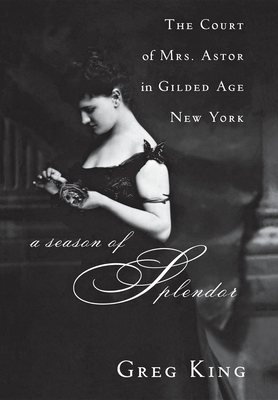A Season of Splendor: The Court of Mrs. Astor in Gilded Age New York by Greg King
Summary (from the publisher): "Every aspect of life in the Gilded Age took on deeper, transcendent meaning intended to prove the greatness of America: residences beautified their surroundings; works of art uplifted and were shared with the public; clothing exhibited evidence of breeding; jewelry testified to cultured taste and wealth; dinners demonstrated sophisticated palates; and balls rivaled those of European courts in their refinement. The message was unmistakable: the United States had arrived culturally, and Caroline Astor and her circle were intent on leading the nation to unimagined heights of glory." - From A Season of SplendorTake a dazzling journey through the Gilded Age, the period from roughly the 1870s to 1914, when bluebloods from older, established families met the nouveau riche headlong railway barons, steel magnates, and Wall Street speculators and forged an uneasy and glittering new society in New York City. The best of the best were Caroline Astor's 400 families, and she shaped and ruled this high society with steel.
A Season of Splendor is a panoramic sweep across this sumptuous landscape, presenting the families, the wealth, the balls, the clothing, and the mansions in vivid detail as well as the shocking end of the era with the sinking of the Titanic.
Review: As the title suggests, this was a broad history of the elite of New York City during the Gilded Age. King takes the reader on a journey looking at the prominent families, their social lives including extravagant entertaining, their elaborate and grandiose homes and vacation houses, their society scandals, and general practices including wardrobe, jewelry, basic etiquette, and household routines. At heart, this time period was defined by the "struggle for primacy between tradition and social evolution, between old money and new, between families of respected lineage and social upstarts who dared challenge convention" (4). The books numerous descriptions of over-the-top parties, homes that cost millions of dollars and hundreds of men to build, and other extravagant details like the finely decorated yachts, and millions of dollars in jewels is truly awe inspiring and the sheer extent of the opulence of their lives is difficult to fully comprehend.
While focusing largely on the Astors and Vanderbilts, this book does a great job at presenting more of a survey look at many of the top names in society at the time and a general look at Gilded Age lifestyle rather than a comprehensive biography of any one family or individual. Some of my favorite aspects were of the marriages gone wrong, the descriptions of extravagant balls and parties, and the detailed descriptions of the mansions of the day. Although I have previously read biographies of the Astors and Vanderbilts and other families from the time period, I learned so much from this book thanks to the author's detailed inclusion of the way daily life ran and operated from that time. For instance, most of the great hostesses of the day all used the same woman to hand address their formal invitations and her distinctive handwriting would have been recognized by those receiving them (350). King is also meticulous in detailing just how extravagant the lifestyles were. For instance, many families summered in Newport, which cost a fortune: "It was not unusual for a family to spend $2,000 to $4,000 ($46,000 - $92,000 in 2008) per week during their stays, with the most magnificent balls occasionally running near $100,000 ($2.3 million in 2008) (333).
This was a well-researched and entertaining panoramic look at a time of splendor and excess that is hard to now imagine. It would be an excellent introduction to the time period and does a credible job of thoroughly exploring life of the wealthiest New Yorkers from the 1870s until roughly the sinking of the Titanic in 1912.
Stars: 4
Related Titles:
- Fortune's Children: The Fall of the House of Vanderbilt by Arthur T. Vanderbilt II
- Consuelo and Alva Vanderbilt: A Story of a Daughter and a Mother in the Gilded Age by Amanda Mackenzie Stuart
- The Glitter and the Gold: The American Duchess - In Her Own Words by Consuelo Vanderbilt Balsan
- Emily Post: Daughter of the Gilded Age, Mistress of American Manners by Laura Claridge
- Empty Mansions: The Mysterious Life of Huguette Clark and the Spending of a Great American Fortune by Bill Dedman and Paul Clark Newell, Jr.
- Collecting Shakespeare: The Story of Henry and Emily Folger by Stephen H. Grant



Comments
Post a Comment